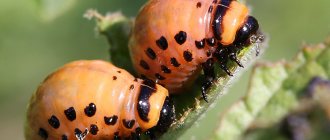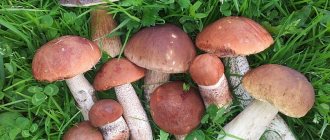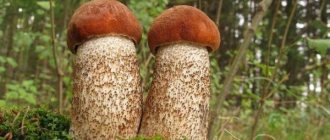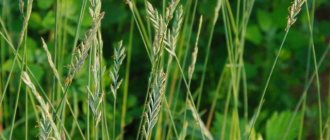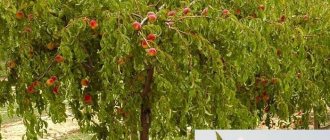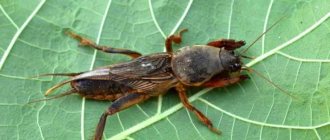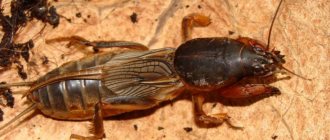How is this parasite different?
The first feature that catches your eye is its gluttony. It is believed that its homeland is North America. He remained in the shadows for a long time until he began to rapidly destroy entire potato plantations. The pest is easy to distinguish from other similar parasites, since it grows up to 2 cm in length, and its body is covered with a shell of red or bright orange chitin.
Until the 40s of the 20th century, this pest did not yet exist in Europe. He happily eats not only potatoes, but also tomatoes, eggplants, peppers, etc. As a rule, the greatest danger is posed by the larva of the cockchafer, which penetrates into the soil along with humus. After wintering, insects climb out of the ground to the surface in search of food. Insects wait out cold and frost at a depth of about half a meter, so fighting them is not easy.
With the arrival of spring, female cockchafers begin to lay eggs, after which larvae emerge from them, and they are quite voracious and eat everything that comes in their way. Externally, the larvae look like white caterpillars with many small legs. They live for about 4 years. The larvae are armed with quite powerful jaws, as a result of which they can destroy the root system of any tree, not to mention garden crops.
Somewhere in the height of summer, the larva begins to develop into a pupa, which resembles a real adult cockchafer. By autumn, the pupa turns into an adult, which overwinters in the ground at great depths. This allows the cockchafer to survive the harshest winters.
The survivability of this parasite is associated with many factors. For example:
- In Europe, the cockchafer has practically no natural enemies, compared to its homeland.
- If there are no favorable conditions and there is not enough food, then the cockchafer can be in a state of suspended animation for 3 years. After this period, the parasite is able to come to life and begin its “violent” activity.
- Female insects lay eggs at great depths, so no agricultural measures can affect this process. Therefore, the destruction of such pests must be carried out during the period of their active life.
- The cockchafer has strong wings, so it can easily fly a distance of 10 km. As a rule, they migrate in entire colonies in search of food. At the same time, they capture significant territories.
- To destroy this parasite in a vegetable garden or garden plot, you need to put in a lot of effort and money.
Despite this, many effective means have been developed that can cope with the invasion of the cockchafer. At the same time, it must be remembered that chemical control agents require special protective equipment, otherwise they can harm humans, although in our time drugs with minimal toxicity are produced.
Lifestyle of the mole cricket
Kapustyanka is an ancient species of insects that appeared on our planet among the first millions of years ago, so it is difficult to fight this pest. It is resilient and easily adapts to changes in the environmental conditions in which it lives.
Photos of the garden pest demonstrate that the mole cricket genus is orthoptera. With the help of its wings , the beetle moves long distances in search of food. A large number of legs that perform different functions allows it to swim .
Mole cricket wings
To understand how to get rid of a mole cricket, you need to know what kind of life this insect leads. During the daytime, it hides in underground passages and hunts mainly at night . You can see where the cabbage grass has crawled by the winding loosening of the soil and small holes in the ground. If a healthy plant grew nearby and began to die , then it was most likely spoiled by an insect pest.
Mole crickets lay their eggs in nests near plants. To ensure that the nest is well ventilated, the female constantly cleans the underground tunnels. She gnaws the roots of plants that cast a shadow on the nest, so the plant crops die. The mole cricket larva can also cause a lot of harm to gardeners. It gnaws small roots, after which the crop begins to hurt and wither.
The fight against cabbage weed must begin in the fall . All crops should be removed from the land, even fruits and roots that are not suitable for food. With the arrival of spring, the remaining fruits are good food for the insect.
May beetle larva
With the appearance of the first leaves, the female beetle burrows to a depth of approximately 1 meter and lays eggs there (slightly whitish and transparent in color). Because of their deep location, it is almost impossible to detect them in time. After laying a clutch, the female dies. After 20 days, the eggs hatch into thick larvae with rings and spots on their sides. As they grow, they begin to rise to the surface, feeding on the roots of cultivated and weed plants, and can travel a distance of 100 meters. The development of the larva to the adult takes more than one year, but about 5 years.
Diagram of the development of the cockchafer - from eggs to adults.
Gradually growing, the larva becomes like a thick yellow caterpillar with a brown eyeless head (sight is not needed due to its underground lifestyle), three pairs of hairy legs, and a gnawing mouthpart. The abdomen is slightly darker than the rest of the body, since digested food shines through it. Brown spots are visible on the sides of the baby's rings.
The cockchafer is not picky about its diet, but loves to live in a layer of manure. Sometimes it gnaws potato tubers, but gives greater preference to soils under strawberries and berry bushes. Of the trees, apple trees, apricots and pears suffer the most from Khrushchev.
Adults reach a length of about 4-7 cm, and most often they cause damage to the plant. When comparing adult and young individuals, it is clear that the larva exceeds the imago in growth.
When the root system is damaged by a pest, the green mass begins to rapidly wither, and then the plant dies. In terms of damage to plants, the May beetle can be a worthy competitor to the Colorado potato beetle.
The larvae live well in fallen leaves. Therefore, it is recommended to regularly remove it from the ground. Also, if individuals are found during the digging of the garden, it is recommended to collect them in a separate container and destroy them. Thickets of grass and stumps are also attractive habitats for beetles; it is better to remove them.
In the photo: comparison of an adult May beetle and its larva (Khrushchev).
To prevent the appearance of the pest, the soil must be regularly dug deep (20 cm) and mulched. Moles are excellent at fighting the May beetle, so it is better not to bury the burrows of this rodent. Also, the smell of cruciferous plants, marigolds and lupins near the crop repels insects. People's pest prevention measures include planting fodder turnips along the edges of the bed, burying cabbage leaves and mustard shoots in the ground.
The larva of the cockchafer brings not only harm to the garden. It perfectly aerates the soil, which contributes to better water and thermal permeability of the soil. Those who breed poultry use the larvae as food, and fishermen claim that ide and smut are excellent bites on the beetle.
The cockchafer larva is often confused with the second stage of bronze beetle development. Only the second does not harm plants, but rather enriches the earth with waste products.
External features
Mole crickets are the oldest inhabitants of the planet; the fossil remains of some species that lived on the territory of modern Europe are about 30 million years old. These insects are extremely tenacious and easily adapt to any living conditions, so they are found everywhere.
Medvedka.Medvedka.
Throughout their lives, mole crickets are actively engaged in building underground tunnels, where they live and reproduce, so among experienced gardeners you can hear another name for the insect - cricket - mole. Underground passages are located at a depth of 10–15 cm and consist of holes and numerous passages - branches, which can run in a network throughout the entire area.
Experienced gardeners know how to distinguish insect larvae, but beginners have to rack their brains.
There are about 500 eggs in a mole cricket's nest. The length of each of them is from 1 to 3 mm. They have a brown, reddish color. Translucent. Under a microscope you can see a living creature in them. The larva develops in the egg for about 2 weeks. Under favorable conditions, it emerges from the shell earlier.
Initially, these are small, helpless, blind creatures that outwardly resemble a bug, but not a caterpillar. They have a reddish color. Their food is the mother's saliva and egg shells. After approximately 7 days, the first molt occurs. Mole cricket larvae increase in size and more closely resemble an adult insect, which even has wings and can fly.
The full stage of imago formation lasts about 2 years. Under favorable conditions – 1.5 years. At the last stage, the genital organs develop. The mole cricket larva has to go through about 10 molts. Each time the body length increases, more and more reminiscent of an adult beetle.
Mole cricket larvae
Many people are concerned about the question of who the bear is. There are debates regarding two families: beetles or insects. The scientific classification is as follows:
- Class insects.
- Order Orthoptera.
- Superfamily Cricketaceae.
- The mole cricket family.
- Genus of mole cricket.
The mole cricket insect in the photo looks very menacing. The front part of the beetle is equipped with a powerful mouthparts and paws that resemble the limbs of a mole.
Appearance of the mole cricket
Upon further examination of the photo of the cabbage plant, attention is drawn to the shell, which begins immediately after the head. In case of danger, the mole cricket beetle hides its head in it
The adult also has wings on its abdomen, which are used by insects only during the process of reproduction.
To fully describe the structure of the mole cricket, it is important to mention its following features:
- Hind springy legs. With their help, the bear can jump.
- There are small claws on the front paws. They allow the insect to quickly dig through hard and dry soil.
- A photograph of a mole cricket shows a pair of whiskers on the front of its head. With their help, the insect catches odors.
- The hearing aid is located on the shins of the forelimbs.
The total lifespan of a mole cricket, taking into account the larval stage and other stages of maturation, is 3 years. Of these, the cabbage weed spends most of its life in the larval stage and only 1 year as an adult. The period for which a mole cricket lives may vary depending on the conditions surrounding it.
The following types of insects are known:
- ordinary;
- African;
- ten-legged;
- steppe;
- single-pin.
The easiest way to distinguish a male from a female is by the venation of the elytra. There are also individuals in which wing formation does not occur. These can be both males and females.
The mole cricket and its larvae adapt well to new conditions and even know how to adapt to poisons of various species. Cabbage grass has few natural enemies, as it is very difficult to detect underground.
Enemies of the mole cricket
Among those who eat mole crickets are:
- moles;
- shrew;
- rooks;
- hoopoes;
- starlings.
Habitat
The common mole cricket has been known to the world for more than 3 million years and has learned to adapt well to various living conditions. The insect preferably lives deep in the soil. It loves warm, moist and nutritious soil, so the main part of its life activity takes place at a depth of up to 30 cm. Cabbage grass can also rise to the surface. Reproduction is the main reason for the insect to enter the upper layers of the soil.
On a note!
The kapustyanka flies well, runs fast and even swims. It chooses well-warmed soil areas as its habitat. For normal life, she needs a sufficient amount of moisture.
The most common habitats of the insect are the European part of Russia, Kazakhstan, and Asia. The only exceptions are the coldest northern regions, such as Norway and Finland.
During the warm period, cabbage grass makes its way to the upper layers of the soil, where it is possible to reach food. The insect can be found at a depth of 10-15 cm. In winter, the mole cricket goes deeper and it is more difficult to find where the crayfish lives. He equips himself a hole 30 cm underground.
Lifestyle of the cockchafer
In the spring, when green leaves begin to bloom on the trees, male cockchafers appear. After 7-10 days, females join them. Many species of cockchafers are especially active at night and in the evening. Some beetles fly actively even in the morning hours before dawn; sometimes they are attracted to artificial light sources. But during the day, especially after eating, the beetles, on the contrary, slow down their activity.
During its short terrestrial life of 30-40 days, the cockchafer nevertheless actively flies; in search of food, it can fly up to 20 km in a day, developing a speed of 8-11 km per hour. During the flight, the Khrushchevs buzz loudly; it is this feature that was aptly noted by the great Ukrainian poet T. Shevchenko.
How to distinguish the larvae of a mole cricket and a cockchafer
Mole crickets and cockchafers are dangerous pests that love soils enriched with humus, manure, and well-irrigated soils. To preserve the harvest, plants, you will need to understand the features and external characteristics
It is especially important to determine what the larva of a mole cricket and a cockchafer looks like and what their differences are, because they can easily be confused from a photo
What does a mole cricket and its larva look like?
The main characteristic of kapustyanka from other representatives is its physical features:
- Large body, reaching 4 cm.
- The color is dark brown above, brown-yellow below.
- Insects with velvety hairs.
- Short antennae with a forward-facing mouth.
- The elytra are wide.
- The wings are well developed and protrude.
- The front legs are similar to a shovel, which allows them to break through the ground and tunnels in root crops. The rest have spikes.
Breeding occurs in May; one female can lay up to five hundred eggs in garbage, manure or in the garden. Development occurs in 20 days, and the larva can be seen after 30 days.
Interesting! If conditions are favorable for the mole cricket, it can grow up to 15 cm.
The insects are visually very disgusting, outwardly similar to adults with a size of up to 3 cm. They have a strong shell, but no wings. To become full-fledged, it goes through stage IV over one to two years. During this development, the shell changes.
Appearance of the cockchafer
The female Khrushchev lays up to 70 eggs at a time to a depth of 15 cm. Often this is followed by death. After 35 days, larvae appear with a yellowish or red body. It is dense but soft, divided into several parts with three pairs of limbs. The upper jaws are located on the head.
The first 3 years it is in the ground, the development stage occurs. As soon as it gets warmer, pests move to the top layer of the bed. The initial nutrition will be humus, the root system of grass, after which they need the roots of trees and fruit plants.
Interesting! A 3-year-old beetle larva can absorb the root system of a young pine tree in 4 hours.
Comparative characteristics
To understand the differences between a cockchafer larva and a mole cricket larva, you need to understand the comparative parameters. The former love the roots of vegetable crops and tubers, while the latter prefer nightshade plants.
Attention! Mole cricket larvae can cause no less harm than an adult beetle, since they feed on the roots of plants in the garden
Similarity
There are practically no similar characteristics. Knowing their description, you can notice a significant difference. Therefore, it is more advisable to study the differences between insects. The only unification is harmfulness.
Differences
The main differences between insects include:
- Mole crickets will damage plants immediately after birth, while cockchafers do this gradually, so the first 2 years are almost harmless.
- Khrushchev prefer warmth more, so they live deeper in the ground, as a result the fight becomes more difficult.
- The May beetle loves the root system and strawberries, and the cabbage beetle loves melons and nightshades.
- The larvae vary in color. Khrushchi are yellowish with pronounced rings on the body, while other insects are brown without rings.
- Maturation is very different; for Khrushchev the entire period takes 5 years, for other pests it takes one to two years.
- The cockchafer is one cm smaller in size.
What to look for when recognizing
Even looking at photos of two types of larvae, you can replace the difference and see that they have nothing in common. Body structure, lifestyle, diet are different.
The peculiarity of the mole cricket is in the front pair of legs, which look like a tool for digging the earth. In addition, both representatives belong to different groups.
May beetles are Coleoptera, mole crickets are Orthoptera, their closest relatives are grasshoppers and locusts.
Khrushchev larvae have powerful jaws, so they easily consume solid foods, roots, humus, potatoes, turnips, and onions.
It is important to identify the larvae promptly, as they can cause serious damage to crops and plants by destroying roots. Nutritious and loose soils are considered optimal for habitat.
In the summer they love potatoes and corn, and eradication will require the use of insecticides.
origin of name
These insects became bearers of the title “mole crickets” for their large size, dark brown color, powerful front legs, and slightly downy body.
The second name of the individual is cabbage, attached due to its great love for the roots of young cabbage. Such a bug is also called a cricket - mole (translated from Latin), and for good reason - because the bug with its body structure fully resembles a cricket, it even creates a corresponding sound.
The name “mole” is also natural and quite logical - it is the front legs that help it easily overcome soil layers in search of the required food.
Also, a less common name is “top” - this name justifies its structure of the front legs. After all, they have sharp ends, slightly reminiscent of the sharp fangs of a wolf.
Reproduction and life expectancy of mole crickets
The mole cricket nest is a unique structure. This is an intricate network of passages, which is located at a distance of 10-15 centimeters from the ground. As a rule, the mole cricket has four exits to the surface, between which there are intricate passages.
In May or June, when the air temperature is not lower than 12 degrees, adult mole crickets leave the ground and come to the surface where mating occurs. At the end of this process, they return to the depths and the females set up a nest. As a rule, the nest is located in the center of the passages.
At one time, she can lay up to 500 eggs measuring 1-2 millimeters. But in order for babies to be born, many conditions must be met: high air humidity (about 100%), warmth and ventilation of the room in which they are located.
That is why the mole cricket takes great care of its clutch. It gnaws the roots of plants so that they die on the surface, thereby increasing the area of sunlight, that is, the earth warms up more.
The female regularly opens and closes the passages to regulate air humidity and temperature. Around the nest, passages are usually dug in a spiral shape. If all conditions are favorable, mole cricket larvae
first age.
They are small, light in color, and outwardly resemble an adult, however, they do not yet have wings. And also, before the first molt they are completely blind, so they do not leave the nest yet. As soon as the time for the first molt of the young comes, they disperse for independent life.
They will have to survive several more molts in order to become an exact copy of their adult parents. As a rule, this takes about 2 years. An interesting fact is that in the adult stage, the mole cricket lives only for a year, while in the growing stage it lives for 2 years. The total lifespan of a healthy insect is 3 years.
When plants in a summer cottage wither, despite their regular watering, there is a high probability that the cause is a mole cricket. The mole cricket is a dangerous pest that can significantly spoil the harvest and destroy perennial plants.
This underground resident spoils the roots of young seedlings and adult plants, which leads to their death.
Other names for the mole cricket are cabbage weed, earthen crayfish, spinning top, mole cricket.
The insect was nicknamed the mole cricket for its brown color and a certain clumsiness in its movements. Kapustyankoy - because he loves cabbage. Due to the resemblance of the forelimbs to claws, some call this pest earthen crayfish. Spinning top - because young larvae have a grayish tint. Mole cricket - due to the fact that the insect somewhat resembles a mole and chirps at night.
Small holes in the beds, as well as loose mounds of earth, can indicate that a mole cricket lives in the garden. After rain they are visible more clearly.
If you dig 15 cm deep into the ground in these traces, you can find laid eggs of pests. Tiny eggs the size of a hemp grain will turn into larvae in 10–17 days, which will also spoil the plants in the garden.
Usually during the day, mole crickets sit in burrows, and in the evening they become active:
they make new passages, destroying plant roots along the way.
Finding and destroying a mole cricket is not the easiest task. These insects fly long distances, move on the ground and swim. Their location can be determined by the characteristic sound made in the evening and at night. It resembles the chirping of a grasshopper, only louder.
In winter,
the mole cricket lives in deep layers of the earth or compost heaps.
In the spring
it begins to become active and rises closer to the surface.
In June
, the insects mate and then lay 500–600 eggs. During this period, the pest is already clearly present in the garden, as can be seen from the signs described above - tubercles and holes in the soil.
Did you know?
Medvedkas are used in pharmaceuticals. These scary-looking insects are considered an effective cure for tuberculosis. Medvedka is also considered effective in the fight against cancer and HIV infections - its use helps improve immunity. Moreover, not all mole crickets are equally useful: Asian insects are more effective in fighting diseases.
What does mole cricket eat?
The mole cricket's diet is extensive: the root system, tubers, seeds, underground parts of the plant, young shoots. The pest likes fruit, vegetable, berry, garden, and melon crops:
- beet
- potato
- cabbage
- cucumbers
- pepper
- tomatoes
- melons
- watermelons
- sunflower
- strawberry
- parsley
- beans
- wheat
- oats
- corn
- millet
- various shrubs
One adult can destroy up to 15 plants per night.
In warm regions, the insect feeds on citrus fruits, cotton, tea, and peanuts. In gardens, trees that suffer from cabbage weed include cherry, pear, apple, peach, and apricot. In forests, the beetle's diet includes the roots of young trees: oak, pine, spruce, and beech.
An adult is a predator that eats worms, ladybugs, larvae of May and Colorado beetles. Plants often die because cabbage grass moves underground in search of animal food and damages the root system on its way.
larva feeds on small roots, seeds, worms, and small insect larvae, as it leads a sedentary lifestyle and has poorly developed jaws.
Pest control
Today, gardeners and gardeners have at their disposal a whole arsenal of old folk methods for preventing and combating earthen cancer, as well as a lot of chemicals and devices that allow them to get rid of uninvited guests:
- manure traps;
- beer lures;
- soap and kerosene “baths”;
- aromatherapy;
- “onion shower”;
- installation of wind turbines;
- sound repellers;
- insecticidal preparations.
Fighting insects that survived mammoths and dinosaurs is not so easy. Adherents of organic farming are recommended to use time-tested folk methods, and only as a last resort switch to chemicals.
Mint, bird cherry, chrysanthemums, calendula and garlic are the main natural ingredients with which summer residents fight mole crickets. They plant these plants in different parts of the garden to protect other crops.
But in most cases, chemicals are used to kill arthropods. Deep loosening of the soil is still practiced, but the insect quickly colonizes the beds again and again.
Pests actually enter the plots with manure brought from outside. To prevent the mole cricket from surviving, it is advisable to deliver fertilizer to the beds just before the start of winter. Does not like cabbage and ash, as well as alkaline chemicals.
Since cabbage mushrooms do not “respect” alkali, soap solutions can be poured into the burrows. The pest crawls outside, where it risks being caught by a summer resident.
For a good, effective result, add real (fragrant) sunflower oil to the grains of oats, grains, or other cereals, mix well and add toxic chemicals directly to the grain. Next, you need to distribute it evenly over the area, raking it with a rake.
Ways to deal with mole crickets
General economic
- A private farm requires an area for storing and maturing manure and compost. If manure is dumped in a disorderly area and food waste is scattered, it means that the mole cricket (and other pests and diseases) have created optimal conditions for wintering and breeding.
- It is more advisable to apply manure and composts to the soil after maturation. If fresh manure is to be added, it is taken to the garden after harvesting and placed in small piles in a checkerboard pattern. In this case, the garden is dug up in late autumn. Before digging, the heaps are turned over, adult mole crickets, numb from the cold, are selected, manure is scattered around the site and dug to a depth of 25-30 cm.
- The mole cricket is a “gourmet” and cannot tolerate unpleasant odors emanating from food. In particular, she does not tolerate the smell of root secretions of alder and bird cherry. Usually the insect tries not to violate the boundaries of the area, but the unpleasant “aroma” forces it to leave the inhabited area at the first opportunity. Marigolds and calendula are the same allergens for her. The beds of potatoes, eggplants, and tomatoes planted with these plants are not visited by mole crickets during the growing season; they go to other places.
Young mole cricket larvae.
Rimantas Vilius Proper gardening requires the obligatory implementation of the basic principle of agricultural technology - compliance with crop rotation. It is the correct distribution of crops that helps to carry out all plant care measures in a timely manner, which contribute to a significant reduction in the number of pests per unit area. Grinding post-harvest plant residues, deep digging (in the southern regions it is better with soil turnover), high-quality spring-summer inter-row tillage causes the death of up to 70-90% of soil and plant pests. Deep loosening (12-15 cm) of row spacing is especially effective until the end of June, as it does not damage the young roots of planted plants, but destroys the underground communications of mole cricket overwintering areas and destroys their eggs and larvae. On acidified soils, introducing a large amount of ash into furrows along the perimeter of plantings and paths repels the pest
Attention! On neutral and alkaline soils, adding ash in large quantities is not recommended. Increased soil alkalinity has a depressing effect on a number of vegetable crops
Compliance with the irrigation regime provides plants with favorable conditions for crop formation and increases resistance to pests
Excessive moisture leads to a significant increase in their numbers. All protective measures must be carried out according to the development cycles of pests, including mole crickets. Premature or late implementation of protection will not provide a significant result. Adult individuals may die, but the young generation (300-400 individuals from each nest) will fill the garden.
Prevention measures
The mole cricket is a very tenacious insect, easily adapting to various conditions and capable of moving long distances. Therefore, if it becomes known that neighboring areas have been attacked, it is necessary to urgently take measures to prevent soil contamination.
For prevention, you need to use the following methods:
- in spring and autumn, dig up the soil on the site;
- try to avoid using manure as a fertilizer, since it is in it that mole crickets often enter the area; it is safer to replace it with chicken droppings;
- in the rows and along the entire perimeter of the garden, plant plants with a mole cricket-repellent aroma - coriander, marigolds or chrysanthemums;
- to reduce soil temperature, use mulching with light-colored materials - straw or sand;
- monitor the level of soil moisture and not allow it to exceed it; it is especially important to observe this point in greenhouses.
Harm in the garden
At first, the presence of a mole cricket on the site may not even be noticed, then the activity of the pests reveals a number of characteristic signs:
- swollen areas of soil above nests;
- paths - furrows in the beds, clearly visible after rain and watering;
- open entrances - holes in the hole;
- causeless withering of seedlings and seedlings;
- death of young seedlings;
- damaged roots.
Harm from the mole cricket
In most cases, the mole cricket is discovered during excavation work. The insect rarely comes to the surface, so it is easier to detect it in pits and holes. But if the mole cricket beetle is found late, then the chances of saving the crop may be too low.
The presence of a pest in a summer cottage should be indicated by the following factors:
- withering of crops;
- damage to root crops, crayfish actively uses vegetable pulp as food;
- death of seedlings simultaneously and in large quantities;
- mole cricket passages, they become especially noticeable in wet areas of the garden;
- round holes on the surface of the ground that serve as the entrance to numerous insect burrows.
The presence of these signs may be a warning of danger. You need to act quickly and purposefully.
Important!
There are many ways to combat insects, but the most effective is still the use of chemical insecticides, which will quickly eliminate the problem and save the entire crop. Knowing where cabbage grass lives will help you fight it more effectively. Since it is better to put the poison in insect holes.
Having discovered traces of cabbage grass in the garden, you should immediately take measures to combat the insect. In a short period of time, earthen cancer can significantly reduce the amount of harvest, as well as spoil a large number of plants.
The insect is not particularly scrupulous in its choice of food, so it can consume almost all crops in the garden beds. Most often it affects:
- potato;
- carrot;
- beets;
- cabbage;
- eggplant;
- tomatoes;
- pepper.
Another unpleasant feature of the appearance of cabbage grass in the beds is its lifestyle. It digs through numerous underground passages and lays larvae in them. And everything that comes her way is mercilessly chewed and bitten. The results of such vital activity are the death of many plants. Mole cricket burrows in the garden are at different levels up to 30 cm deep, so almost all plants are affected.
Mole cricket eggs left in burrows turn into larvae. They also use the root system of plants as food and only worsen the damage. Therefore, when planting plants, you should take into account not only what the mole cricket eats, but also the crops that it does not eat.
Thus, in order to effectively fight and protect your land, you need to carefully study the photo and description of the mole cricket
For faster victory and minimizing damage, it is important to learn how to quickly determine the places of greatest concentration of individuals and act on them using special insecticides or folk remedies
Having become familiar with the appearance of each insect and the features of nest construction, we can highlight the main differences:
The mole cricket does not go through the worm or pupa stage. It immediately appears in the form of a small insect. It has a brown color, but darkens over time. At the last stage, wings and genitals develop. All this takes about 2 years. May beetle larvae are white caterpillars with well-defined rings. They gradually increase in size, reaching a length of 6 cm. They have a twisted ring shape. The head is brown. In the front there are 3 pairs of legs
This is important to remember, since similar caterpillars are found in the larvae of other beetles that do not harm crops.
In small numbers on a plot of land, the larvae do not cause much harm. This applies to both mole crickets and the May beetle. They loosen the soil and saturate it with useful substances. However, their large numbers can negate all the efforts of the gardener.
Where does the bear live?
Cabbage grass lives almost throughout the entire European territory, with the exception of the Netherlands, Finland, and Norway. Residents of the Caucasus, Southeast and Central Asia, India, China, the Japanese and Philippine Islands, Australia, South and North America, and the Northern regions of Africa have to fight the pest. In Russia, the insect is found almost everywhere, with the exception of the northern regions.
The beetle lives in damp places, meadows, near ponds, and lives in tunnels underground. The insect likes fertilized, warm, humus soil, so it is often found in summer cottages, wetlands and near irrigation canals.
May beetle and its larva
To get rid of cockchafer larvae
, it is necessary to establish the reason for their appearance, under what conditions the beetle and its larva can live well. It is necessary to remove comfortable living conditions for the beetle and the larvae of the cockchafer, creating conditions that are unbearable for the pest, so that it lays the larvae in another place, outside your area.
Also keep in mind that you should not confuse the larvae of the cockchafer and the larvae of the bronze beetle - after all, their nutrition is completely different, the conditions of reproduction and the lifespan of the larvae are also different. These larvae are very different in appearance from each other.
Natural enemies of mole crickets
The beetle is to the taste of many animals, is susceptible to fungal diseases, and acts as an intermediate link in the reproduction cycle of other insect species.
Moles feed on cabbage grass ; birds, lizards, rodents, toads, and spiders prey on it.
Burrowing wasp and mole cricket
Wasps lay eggs in the insect's body. The body of the cabbage plant serves as food for the hatched larvae.
